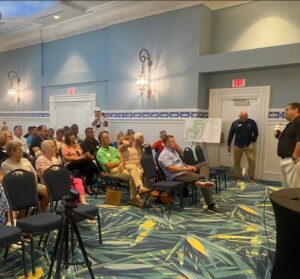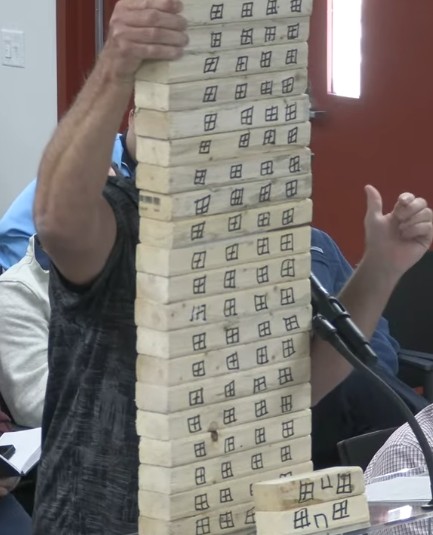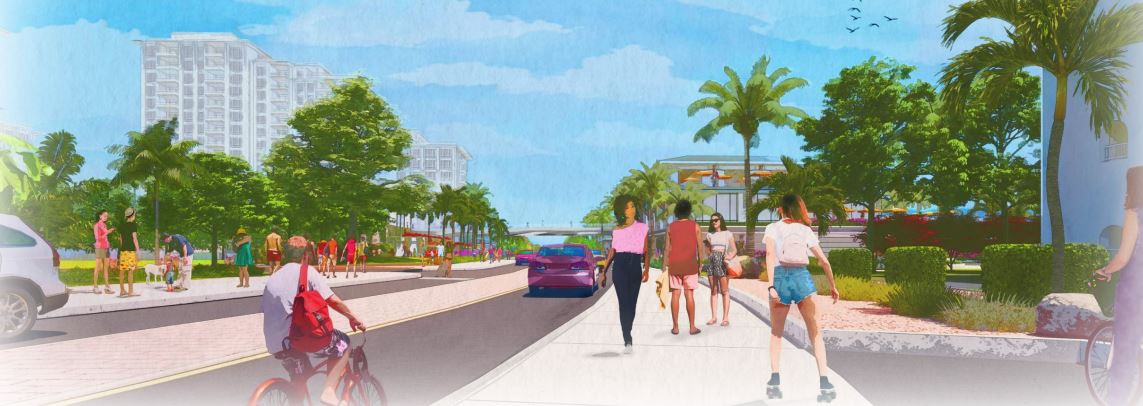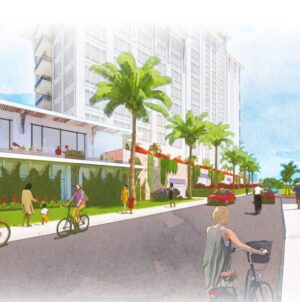In a 72-page document filed with the Circuit Court on Thursday, attorneys for the Town of Fort Myers Beach and local developer Seagate asked Judge Michael McHugh to deny the challenge made to the Town Council’s decision to approve the Red Coconut redevelopment project.
10 residents who live near the former Red Coconut property challenged the Town Council’s decision to approve the Seagate development which includes two buildings that could go as high as 17 stories and other tall buildings. The 10 residents were part of a larger group called Protect FMB that has raised tens of thousands of dollars to fight the development’s approval by the town in court.
The neighbors argue that the Town Council’s approval was not supported by competent substantial evidence, the application departed from the essential requirements of the law, and it deprived residents who opposed the project due process. In essence what they are saying is the Town Council did not follow the rules set forth in their own Comprehensive Plan and Land Development Code.
The town and Seagate are responding jointly. They stated that the residents who filed the Writ of Certiorari to challenge the project lack standing, made weak arguments, and did not provide the court with a full and fair statement of facts. They also state that the project “provides a plethora of public benefits.”
The town and Seagate argue that the neighbors have no standing in this case. “Litigants must have a “legally cognizable interest” that will be affected by the litigation’s outcome.” So what specifically does that mean? According to the filing: “Injury in fact” that is concrete, distinct, palpable, and either actual or imminent; A “casual connection between the injury and the conduct complained of”; And a “substantial likelihood that the requested relief will remedy the alleged injury in fact.”
The town and Seagate say residents have not met this exceedingly high burden. “In fact, their petition fails to assert any damages to them from the development agreement or the height deviation—much less injury differing in kind, not just degree, from the rest of the community. At best, the residents only alleged their property’s location visà-vis Seagate’s.” The town and Seagate also state that other than Mike Dagnese and the Riddles, the eight other residents never appeared to present evidence or objections so they are automatically disqualified from having standing. And, proximity to Seagate’s property does not, alone, establish standing.
The town and Seagate also state “that residents’ sole complaint concerns the height deviation. But after extensive revisions, exhibits, and testimony at four evidentiary hearings, the town adopted the development agreement after finding it consistent with the town’s Comprehensive Plan and in the town’s best interest.”
The filing states that what Seagate could have developed by right—and what many developers do to maximize their development’s value—is a resort hotel, like Margaritaville. “Under this scenario, Seagate could maximize everything closest to the beach, seek to put as many units as possible—which the code allows for more hotel-dwelling units than residential—and Seagate could have also sought a higher density under this scenario. By right, the Comprehensive Plan and LDC allowed Seagate to build four stories on the Gulf/beach and three on the Bay spread over 9.8 of the 10+ acre property. Seagate could have reduced costs by doing the bare minimum under the LDC, such as providing only a 50-foot view corridor and no other public benefits.”
In addition the town and Seagate argue that over a two-year period, Seagate and the town went “well beyond the approved procedures to reach a development agreement. For example, before even applying, Seagate held extensive discussions with individual Town Councilmembers and staff about potential public benefits. It also held town hall public meetings, appeared on local radio shows, and gave the public direct access to Seagate’s principal owner’s cell phone to solicit public input.”
Answering the charge that the town did not give residents due process, the town and Seagate argue that residents certainly were given due process. “The development-agreement process requires only three hearings—one before the Planning Agency and two before Town Council. Seagate and the Town had four hearings to ensure everyone had adequate notice and opportunity to appear and present evidence and argument before impartial decisionmakers like due process demands. Most of the residents squandered those opportunities by not appearing at any of those hearings. And while Dagnese appeared at all four and the Riddles at the last, they still failed to preserve their petition’s arguments. So further due process was unnecessary. The public was allowed to comment at each meeting after crossexaminations. Of the 11 petitioners who filed this certiorari proceeding, only three actually appeared and commented: Michael P. Dagnese, Danil K. Riddle, and Jane N. Riddle.”

The town and Seagate say that the court’s review of the Town Council’s approval is limited to three narrow questions:
1. Whether the Town’s decision observed the essential requirements of the law?
2. Whether the Town afforded procedural due process?
3. Whether the Town’s decision is supported by competent, substantial evidence?
The filing goes on to say that even if the court considers the merits, it must deny certiorari relief because the development agreement’s approval affirmatively meets each question. “As the Supreme Court has repeatedly held, a court cannot grant certiorari over a mere disagreement in interpretation. If the town applied and interpreted the correct law and no clearly established precedent has reached a contrary interpretation or application, then this Court must deny certiorari relief.”
The LPA voted to deny the project 4-2. The Town Council approved it 3-2. In addition to this court case approval of the Seagate proposal is the reason there is a campaign to recall Council members John King and Karen Woodson and it has divided a lot of the community, just like the two votes.

Local journalism is hard work. If you appreciate the most in-depth reporting on Fort Myers Beach, please support what we do HERE by Venmo, Zell or PayPal. Thank you.


The only public benefit feasible would be to have a 5 story stripper pole on times square
John King and Karen Woodson are useless idiots.
Residents “squandered” the opportunity to Email, attend Town Halls etc., ??
How dare they — the residents of Ft Myers Beach, to this day, are still and continuing to pick up pieces of their lives to try and put together – permits still being waited on – 3 years in !
More time given to Developers than the Tax paying Residents of this Island.
As stated —— many meetings with Council members resulting in:
———- “pleuthera of Public Benefits”
how dare you put that into words !
✔️ Massive density
✔️ Decrease in parking ok’d by Council ✔️Estero Blvd will become a Parking
Lot – not a “road” ….
✔️ Who knows what will happen with
Infrastructure ….
These are are “Benefits” most residents are expecting !
I miss the “can man”. Peace out and good luck FMB!
I would also think it would affect or kill the vegetation in the Forest Preserve behind Seagate with the height of the buildings. I have family close by that we visit often and the Forest Preserve is very protective of their land there.
In addition, one huge thing is the traffic. I’m not sure how we can keep having these building built with such high density and we have no restrictions on coming to the island. If the people who are in favor of this type of building want to continue, we need a toll like Sanibel or passes. Those of us who live there are trapped in our properties most of the season until Easter. Maybe we ought to eliminate personal cars on the island and have buses that continously run up and down the island for 6 months of the year. Build a huge parking lot off the island to park and ride for residents. The island is so tight, how do all of you think we can keep squeezing in these tall buildings on 7 miles. It is ridiculous.
“such high density”?
Seagate is below the number of units they’re allowed by right (150); their plan is for 141 units (137 condos and 4 SFHs).
Increased teaffic is a week argument. How many occupiable spaces did Red Cocunit have? Additionally, there are significantly less businesses hotels, motels, rental condos, and single family homes on the island than pre-ian. Simple math would indicate that there is less traffic post Ian. This will certainly be the case as reconstruction slows and less contracted employees are traveling to, and from, the island
How disappointing. I hope the Judge finds the Town’s response as disgusting as I do. Shameful that they do not want a higher court to review the case. They should at least try to represen all the citizens. They know it was standing room only. People need to realize there are MANY who are against Seagate’s height who haven’t signed up for a recall.
Approve more projects like this, keep the economy healthy, if people don’t like it they can move somewhere else
I wish people would have the gumption to sign their real names.
Dp and g need to go. I’m sure Miami would suit them just fine. Thieves and scoundrels have taken over this tiny paradise island. On both sides.
Once again folks, we forget the option of compromise with the developers; there must be a middle ground somewhere. As it stands, the only people who are benefiting from all of this back and forth are the lawyers. The approval and completion of Margaritaville opened the gates to this kind of development on the island, so it is going to happen sooner or later.
Let’s go. Approve the Seagate development.
Yes, this is a capitalist country, if the island won’t meet your desires move somewhere else
This decision affects ALL residents of FMB, not just those in close proximity to the Seagate development. It opens the door for all of the other developers who are just waiting for this decision to get their projects approved. Since 1995, the town has held off the tall buildings. It’s only been since Hurricane Ian that we became aware that our infrastructure needs to catch up to handle the current number of residents, let alone adding thousands more. We built our house on the south end of the island in 1988, we had always wanted to retire here, but we now have our house listed for sale. This “new” FMB is not for us.
We lived and owned a home on the beach from 2-1995 to 12-2021. We saw the writing on the wall with Margaritaville’s approval. Escaped just in time. Good luck selling.
I haven’t heard anything about the part of the Writ suit that speaks to a development’s proximity to other tall buildings being a prerequisite to qualify to ask for additional height. Seems this is a key issue. (Maybe I misread it??)
Also, I don’t think it’s in the writ, but what about the walkway in the “park” that Seagate is claiming as public benefit that doesn’t belong to them??? How is this not being challenged somehow??
the town and Seagate should be very embarrassed with this response ,
they don’t respect the residents.
Don’t respect which residents? The ones that side with the recall crowd? Or the rest of the town who are embarrassed by the actions of the recallers.
the residents that live in the neighborhood and went to the meetings. And gave their names rather than hiding behind an initial or two